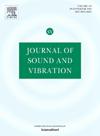Dynamic analysis method of cable structures based on coupled integration algorithm
IF 4.3
2区 工程技术
Q1 ACOUSTICS
引用次数: 0
Abstract
Cable structures are widely used in civil engineering structures such as suspension bridges, catenary systems, and transmission lines because of their light weight and good stretchability. But in these structures, the flexible cable is easy to produce large deformation and large displacement under dynamic actions. The characteristics of complex geometric nonlinearity makes its dynamic research face great problems. The absolute nodal coordinate formulation (ANCF) is widely used in the dynamic modeling and analysis of cable structures due to its advantages of accurately and effectively dealing with large deformation problems. However, the formed equations of ANCF are usually differential algebraic equations (DAEs), which are not suitable to be solved by direct integration methods. Therefore, this paper innovatively derives a coupled integration algorithm for solving the DAEs—GC-α method. This algorithm is conceived along the principle of GC coupled integration algorithm, and the generalized α method with numerical damping is introduced to ensure the stability of the algorithm and reduce the adverse effects of high-frequency components in the vibration of cable structures. By combining this algorithm with the ANCF, a dynamic analysis method of cable structures is proposed. Finally, the accuracy and dependability of the analytical approach are verified by the simulations of free vibration, forced vibration, free fall of a single cable and real engineering cases.
求助全文
约1分钟内获得全文
求助全文
来源期刊

Journal of Sound and Vibration
工程技术-工程:机械
CiteScore
9.10
自引率
10.60%
发文量
551
审稿时长
69 days
期刊介绍:
The Journal of Sound and Vibration (JSV) is an independent journal devoted to the prompt publication of original papers, both theoretical and experimental, that provide new information on any aspect of sound or vibration. There is an emphasis on fundamental work that has potential for practical application.
JSV was founded and operates on the premise that the subject of sound and vibration requires a journal that publishes papers of a high technical standard across the various subdisciplines, thus facilitating awareness of techniques and discoveries in one area that may be applicable in others.
 求助内容:
求助内容: 应助结果提醒方式:
应助结果提醒方式:


